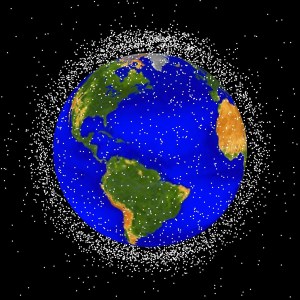Here’s a consequence of climate change you probably haven’t thought of. Space buffs know that Earth orbit is littered with junk, including defunct satellites, spent rocket boosters, and other random debris–about 11,500 objects bigger than 4 inches across, according to NASA’s Orbital Debris Program Office (it’s their graphic you’re looking at). It’s a worry: every one of these speeding bits of hardware could potentially damage, or even smash up a working satellite. The latter could create a lot more debris, potentially triggering something called the Kessler Syndrome, in which fragments of a smashed satellite go on to smash more satellites, creating fragments that go on to smash more…and so on.
What does this have to do with climate change? Maybe a lot.
It turns out that if you warm the lower atmosphere by trapping infrared radiation–the essence of the greenhouse effect–the upper atmosphere should actually get cooler. That’s already been observed, and it’s one of many refutations of the often-repeated claim that the current warming has been caused by a brighter sun (because a brighter sun would warm the stratosphere as well).
Anyway, a new analysis out of the University of Southampton, in the U.K., points out that this cooling actually makes the upper atmosphere contract, removing some of the friction that eventually drags space junk back to Earth (and yes, believe it or not, there’s a tiny bit of air in low-earth orbit, where the space junk problem is most acute). With less falling to Earth, there’s more to slam into working satellites, the International Space Station and whatever else happens to be up there.
The chances that a space collision will unleash the Kessler Syndrome are considered remote for at least the next half-century (although a major collision did happen last year). As the globe continues to warm, though, it appears that those odds will likely have to be recalculated.



